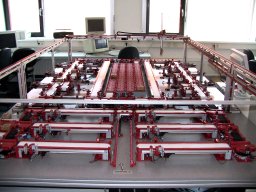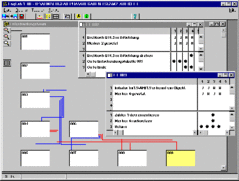Logistics Laboratory
Logistics Laboratory
The Logistics Laboratory is equipped with two model systems with typical structure elements, as for example junctions, joinings und parallel tracks.
The large model

fig.: large model system
This fully functional model of a crane operated unit load conveying system can be used to map and test diverse Material Handling System scenarios. Examples for these scenarios are the modeling, simulation and testing of a picking track of an industrial partner, the supply of an automated production facility with conveyor technics or a sophisticated sorter problem with distribution and sorter.
The model was assembled by the Staudinger GmbH corporation from single modules according to the conception of the Department of Logistics and equipped with an Interbus linkage from Phoenix Contact. The material flow computer "MoveIT" from the RESA company creates per scenario transfer orders from source to drain and tansfers these to the subordinated control "Rattle". After execution of the triggered conveyor movements, the subordinated control reports the arrival at the intended drain to MoveIT via agreed on telegrams and awaits new orders from MoveIT.
RATTLE
The small model
The focus of the analyses at the small model are the control of a complex node, the synchronzation of goods by operating a separating stop and the operation of a storage area using a pusher. Using a convenient discription tool (decision tables) students can develop and test a sequence control on their own.

fig.: small model

fig.: softwaretool for the control of the model
Each flow of material process possesses an informational and a substantial side. With the proviso to provide the right material in the correct quanitity, in the proper quality, at the right place, in time, in an economical and ecological method, it is the mission of the logistic to create and control the flow of materials and information.
During their training the students are provided with the necessary basic knowledge, which they can practically apply at this model. They study how to develop distribution strategies of a complex system and how to react on and solve occuring problems.
Despite the rapid development of computer technology and virtual reality this complex physical model is used for educational purposes, because eventually the Material Handling and Automatization Engineers will have to work on concrete technical constructions. Through the model the students gain the opportunity to become acquainted with the more practical problems of their future working environment. The Logistics Laboratory for this reason also an important element of the Logistikwerkstatt (Logistics Workshop), an innovative educational construction, which is part of the degree programme Mechanical Engineering with specialization in Logistics.